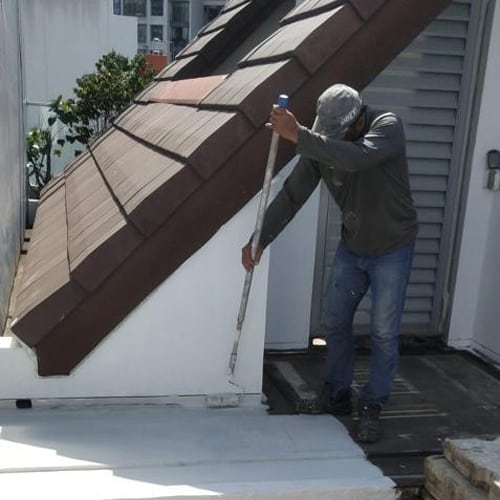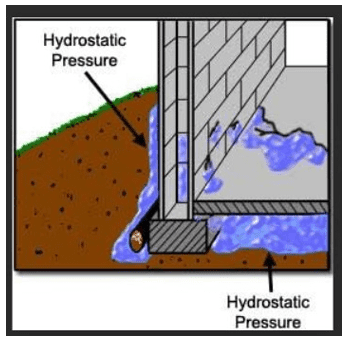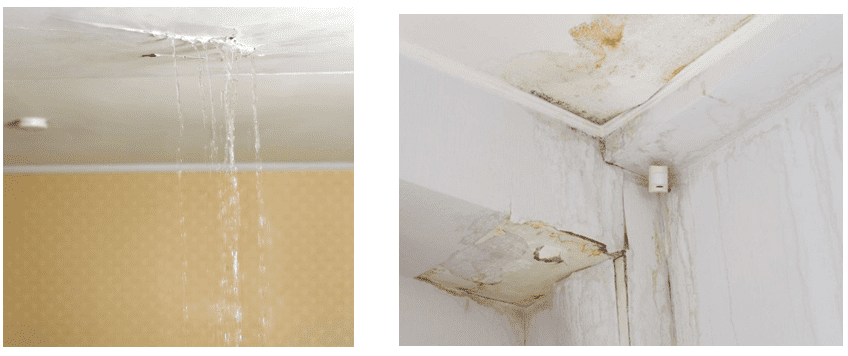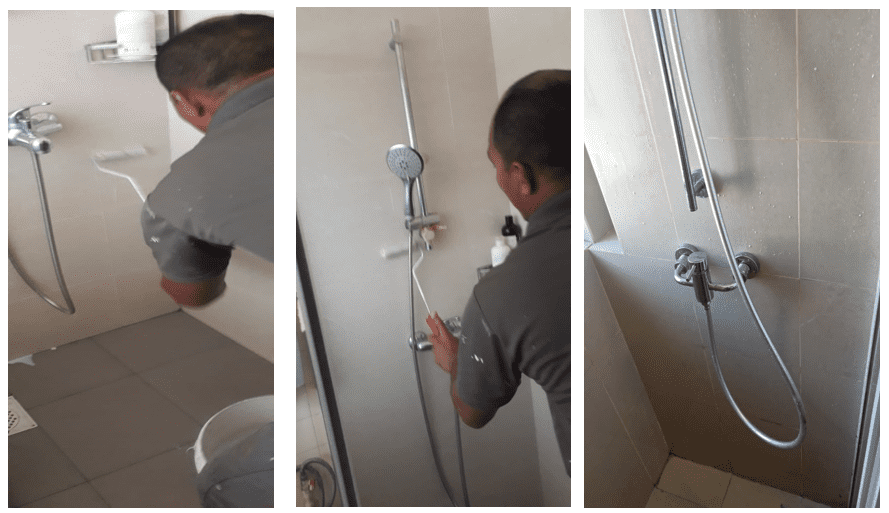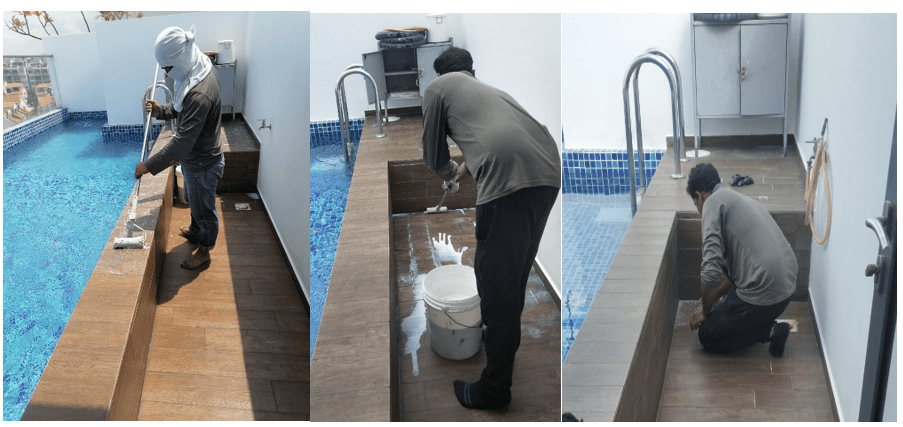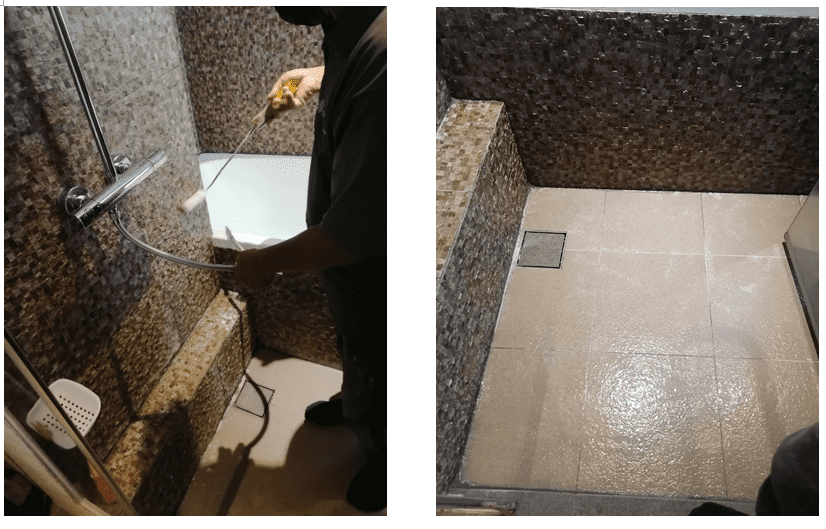Waterproofing protects the structure against water infiltration to provide long-lasting waterproofing protection on a constructed building.
Waterproofing is the application of impermeable layers on the surface of foundations, walls, roofs, and other parts of the building which may be structure, concrete, tiles, marble, and wood floorings, to provide a barrier to prevent water penetrations. Waterproofing is the treatment of a surface to prevent the passage of liquid water in the presence of hydrostatic pressure.
In terms of the foundation, waterproofing means that no liquid will penetrate the concrete foundation wall even under submerged conditions. Therefore, the use of a quality waterproofing system is essential to preserve the water-tightness of the building.
The daily exposure to intense fluctuation in moisture level and temperature in Singapore will contribute to waterproofing deterioration.
When you spot patches of water stain or bubbles in the ceiling.
Don’t worry, you are not alone.
In fact, a lot of homeowners have to face the inconvenient truth of bathroom ceiling water damage.
The question is what to do with a ceiling leak below the bathroom.
Let us give you a simple guide here.
What causes bathroom ceiling water damage?
There are many specific causes of water damage in the ceiling below the bathroom, and they all come back to one culprit: a leak. When the waterproofing protection is worn out, it allows the water to sneak around the edge of the barrier, seeping into the ceiling and sub-floors.
In some cases, the signs of water damage in the bathroom ceiling are obvious: brown spots or water stain marks. In other cases, they are more insidious, such as the growth of mold and mildew.
Leaks usually happen due to long-term wear and tear of the waterproofing membrane or screed in the slab above. Ceiling leaks in the bathroom and toilets are a common problem in Singapore houses.
A leaking bathroom can also pose a safety hazard if water enters electrical fittings, and family members might get electrocutions unknowingly.
Ceiling concrete is a porous material and water can pass through it by hydrostatic pressure, water vapor gradient, or capillary action. Water can also enter cracks, defective structures, or any improperly designed or installed joints. Water infiltration can cause structural damage to the concrete or corrosion to the embedded steel of the building structure. Even the best concrete has a small degree of permeability. A waterproofing system should prevent the passage of liquid water in the presence of hydrostatic pressure.
What is Hydrostatic pressure?
Hydrostatic pressure is the force exerted due to the force of gravity, given the depth whose liquid takes place from the surface as the increase in weights of the fluid happens. This pressure acts with magnitude in all directions, they are not constant.
The main factors which influence it are the liquid’s density and gravity. Hydrostatic pressure can cause flooding, structural damage, and property damage. With such its surface will crack due to foundation/soil settlement, concrete shrinkage, or expansion joint. Capillary will develop within the wall and floor concrete. Moisture infiltration will result in the growth of mold and mildew, dampness on the floor, and saturated wall assembly.
Sign of water damage/leakages
1. Watermark, stain mark, and bubble paint on the ceiling
Water damage ceiling can be a leak from the upstairs bathroom or rooftop. Leaks in the ceiling below a bathroom usually mean the above flooring waterproofing membrane has deteriorated and water moisture is seeping through the concrete slab. Water has penetrated through the flooring into the ceiling below.
In fact, when the ceiling is getting moist between the paint and wall they will eliminate the paint slowly and you will find faded paint, and dark stains, on the ceiling.
Peeling paint is also a sign of leakage from that area which will later develop into stains and watermarks on the ceiling.
Ceiling leaks from above may present themselves as slowly expanding damp spots making their way across the concrete, it may be unnoticed at the initial stage. When the persistent leaks that have been there a long time can turn into a soiled ceiling, falling concrete, or mold issue. Do not ignore the situation when stains and watermarks are spotted on the ceiling.
2. Growth of mold, fungi, and mildew
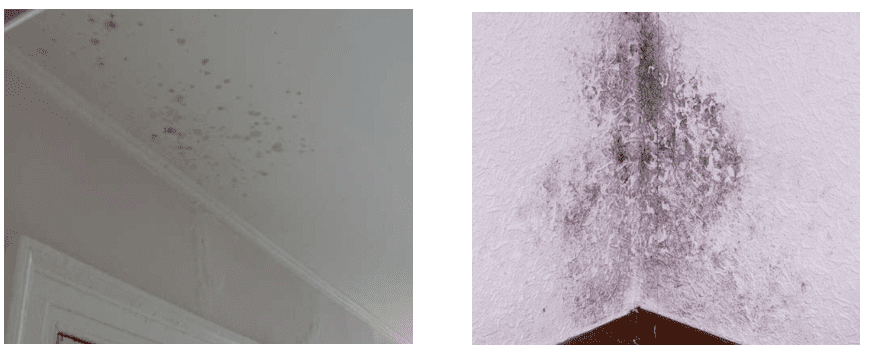
The water leaking causes the wall and other components to get broken and moist will automatically deliver the bad smell and growth of mold and mildew.
Mold and mildew growth is supported by the presence of water and generally occurs where there is humidity in the room. The presence of water on building components depends on air humidity and leakage.
The growth of mold and fungi will develop serious health concerns for the human body for a long duration. It has a specific inhalation reaction to Allergic, Asthma, Hypersensitivity Pneumonitis, and irritation of the eyes, skin, nose, throat, and lungs. The minimum effect will be weakened immune systems of all vulnerable groups of family members, especially young children and the elderly who are staying in the house.
This can be spotted in the interior of the house, exterior of the house, and along the roofs, it is a clear indication that there is a leakage going on in that area.
3. Efflorescence on wall and ceiling
Efflorescence is a deposition of crystalline salt inside or outside of the structure. When efflorescence is formed when there is water contact or water presence in the concrete.
A formation of a powdery deposit on the surface of brickwork, rock, or concrete as a result of moisture on exposure to air. It happens when salt migrates to the surface to form a white coating on concrete, bricks, stone, and wall. Water presence is the prerequisite in the formation of salts. After evaporation of water, the salt is lefts behind on the surface. Basically, it is water or moisture from the environment, mixed with salts that come to concrete and area absorbed and infiltrates over time.
It is a normal and natural occurrence that happens in all cement-based products. In many cases, it will disappear on its own over time. This will result from aesthetic problems to some structural problems.
The first type of efflorescence that happens when concrete is in the curing phase. If water comes out to the surface with soluble minerals or lime, we see primary efflorescence.
It doesn’t occur during concrete drying, rather it happens when some outside soluble salt gets contact with hardened concrete after a long time. Water or moistures from the environment, mixed with salts come to concrete and are absorbed and infiltrates over time. And then after a while, white or grey matter appears.
4. Formation of Stalactite on the ceiling
This is a formation of water dripping through the concrete ceiling. They are calcium deposit that looks like icicles hanging on the ceiling that has been going on for a period of time.
Crystallization can be seen on the leaking concrete. It is a natural process that happens when the water solidifies from a liquid. This process can be carried out by moisture, temperature, and acidity change. The liquid is to be crystallized when the temperature increase and the solubility of a liquid also increase to form a crystal-like substance hanging on the ceiling.
Stalactite formation generally begins over a large area, with multiple paths for the water to flow. As minerals are dissolved in one channel slightly more than other competing channels, the dominant channel begins to draw more and more of the available water, which speeds its growth, ultimately resulting in all other channels being choked off. This is one reason why formations tend to have minimum distances from one another. The larger the formation, the greater the inter-formation distance.
Water seepage from the above will penetrate into the concrete and if the temperature is below freezing, the water will form stalactites. Stalactites can be formed on concrete where there is a slow leak above. The way stalactites form on concrete is due to the presence of calcium oxide in cement. Concrete is made from aggregate, sand, and cement. Over time, any water that penetrates cracks in concrete will carry calcium hydroxide in solution to the edge of the concrete. Stalactites can form when the solution emerges on the underside of the concrete structure where it is suspended in the air, for example, on a ceiling or a beam. When the solution comes into contact with air on the underside of the concrete structure, another chemical reaction takes place. When this solution drops down it leaves behind particles of calcium carbonate and over time these form into a stalactite.
What to do when you have a leak
Finding the source of the leak
When you noticed a damp spot, dark spot, ceiling bubble, or any other sign of a leak from the upstairs bathroom, acting quickly is essential. The longer you wait, the more damage from the leak will spread and your subfloors and joists will be affected.
First thing is to get the leak stopped.
Damaged waterproofing system
If the leak happens very slowly, with the rate dripping around every 2-3 seconds interval, it could be due to a damaged waterproofing system upstairs. Other symptoms include occasional leaks, that will result in a watermark appearing on the ceiling.
Approach the upstairs bathroom and check all the obvious places for leakage. The water supply to the sink, sink trap, water supply lines to the toilet, and drainage area. If the leak is not apparent, touch it with your fingers around the seal to feel the moistness. Once the leak is located, turn off the water supply or reduce the usage in that area.
Plumbing or sanitary Fittings
The plumbing pipes or fixtures are also a potential source of water damage or ceiling leaks. The rate of such leaks is quite constant. If there is visible water damage underneath where pipes are located, the chance of the problem could lie with the pipes. Getting pipes replaced will stop the leak.
Roof Water leakage
Leakage from the roofs is mostly caused by rainwater accumulation on the roof. The leakages usually happen during or after rains, especially more severe during downpours.
Damage to the roof is an unavoidable fact as they are exposed to the elements all the time. Waterproofing damage can result in the infiltration of rainwater into the floor slab and result in damage to the ceiling below. However proper application of the membrane is required, otherwise, rainwater can still find a way to penetrate through the building structure.
Proper rooftop waterproofing systems safeguard the property and building structure in the long term against unwanted water intrusion. Continuous leakage will corrode structural reinforcements within the concrete.
Contact professional waterproofing experts
Should you suspect that you may have a leaking ceiling in the bathroom, call for a professional waterproofing expert, SWC Construction to provide the most effective waterproofing solution to stop the leak and repair it. We are able to evaluate the damage, locate the leak, and propose a good waterproofing solution to fix all kinds of leakage.
Our professional team will carry out a site assessment to track the leakage to its root cause before recommending the most effective waterproofing treatment.
Even if the leak is not obvious, we can evaluate and provide high-technologies thermographic leak detection services to quickly and easily locate the source of the leak. This brings a lot of ease to contractors and homeowners to have peace of mind to resolve the leak once and for all, instead of troubleshooting the source of the ceiling leaks, which could take up a lot of time.
SWC Construction had understudied various waterproofing solution throughout the years and highly recommend our Clear Penetrative treatment (CPT), which is a liquid-applied waterproofing solution that brings its advantage to all Industrial, commercial, and residential waterproofing needs.
Clear Penetrative Treatment (CPT)
A Clear Penetrative Treatment (CPT), is a waterproofing solution designed to provide a thin coating that contains a protective clear coat to impregnate concrete and other facades to repel and protect the treated surface. It gives a non-visible water repellent shield on the treated surface to block moisture ingress. It has excellent properties and exhibits good penetration in both concrete and non-concrete substrates. It provides a good coat to exposure surface from UV damage and reduces efflorescence and mildew formation.
This waterproofing solution is applied to the surface by a roller which will give extra flexibility as compared to other waterproofing solutions. These waterproofing membranes are easy to apply and conform to the surface texture and irregularities of the concrete.
This Clear Penetrative Treatment (CPT) uses a transparent, waterproofing chemical solution that is non-invasive, and non-toxic, with no hacking, or non-massive destructive waterproofing work.
Benefits of Clear Penetrative Treatment (CPT)
- Fast, easy, and safe liquid-applied application
- Less destructive and interruption during application
- Suitable for various types of structures and substrates internally, such as concrete, tiles, and marble in the kitchen, bathroom, shower area, toilets, and all wet rooms.
- Applicable on outdoor areas such as roofs, roads, bridges, basements, terraces, and more
- High elastic, and flexibility allows accommodating minor movement and shrinkage with the structure
- High UV resistance, seamless, retains flexibility at high and low temperature
- Non-flammable technology
- Vapor permeable, entrapped moisture can evaporate, and no blistering will form
- Chemical resistance
- Long-lasting waterproofing coverage of 10 years and more
Application of Clear Penetrative Treatment (CPT)
- Ensure that surfaces to be treated are absorbent.
- Ensure that surfaces are CLEAN in order to enable greater absorption.
- Surfaces must be dry prior to application to achieve maximum penetration depth.
- Surfaces must not have any efflorescence;
- All algae, fungal, and moss growth must be cleared and removed prior to treatment.
- Surfaces must be free of visible cracks.
- Replace or repair all damaged tiles, and concrete surfaces before treatment
- Masonry joints must not have any damage prior to treatment and application.
- Gutter and drainage pipe connections must be tight.
- Expansion joints have to be tight and resistant to solvents.
- There should not be rising dampness in walls. If so, eliminate the source first.
- Glass, windows, doors, and door frames must be protected from the application.
- Remove all plants in the vicinity of the application and areas to be treated.
- Fresh concrete and mortar joints must be cured 3 – 4 weeks before applying treatment.
- Chemical cleaners on surfaces must be rinsed off before application otherwise they may cause discoloration or affect product curing times.
- Wet facades must be checked for neutral reaction (with pH paper) for at least an hour.
- Wet facades must be allowed to dry before the start of treatment.
Case Study 1: Common toilet shower area using Clear Penetrative Waterproofing solution (CPT) at Novena Suite Condominium
Problem: Our client was facing inter-floor waterproofing leakage problems to their lower unit due to wear and tear in the bathroom waterproofing system over the years. The client approached us about the problem.
Solution: We proposed to carry out high-pressure injection grouting to the ceiling slab water leakage area of the lower unit to seal up cracks and joints to stop water ingress. We also carry out Clear Penetrative Treatment (CPT) on their existing shower area to further protect against any water ingress in the future. Our work includes making good of any loose or damaged tile grout and removing existing sealant and toilet bowl and floor joint to ensure good workmanship and effectiveness of this waterproofing work.
Case Study 2: Swimming pool area using Clear Penetrative Waterproofing solution (CPT) at Robey Crescent
Problem: Our client approached us to carry out waterproofing and re-grouting of the swimming pool deck area, where there is a sight of wear and tear of grouting, and are concerned about water seepage from the pool.
Solution: We propose to apply 2 coats of clear penetrative waterproofing solution to the wall and floor tiles to prevent water seepage. Our work includes re-grout of the floor tiles to ensure good workmanship and effectiveness of the waterproofing work.
Case Study 3: Master bedroom toilet using Clear Penetrative Waterproofing solution (CPT) at Kerrisdale Condominium
Problem: Our client was facing a water seepage issue to the external wall and floor joints of their master bedroom toilet. They approached us to carry out waterproofing work to stop the seepage and damage to the wall outside the toilet.
Solution: We propose to apply 2 coats of clear penetrative waterproofing solution to the floor tiles and wall of the Master bedroom toilet to stop and prevent water seepage. Our work includes high-pressure PU Injection grouting to the master bedroom toilet wall and floor joint to stop water ingress to ensure good waterproofing coverage and effectiveness.
Common questions about Clear Penetrative Treatment
Q1. Hacking vs non-hacking waterproofing method
Traditional, waterproofing replacement will require massive hacking and waterproofing of the flooring and followed by tiling. This is a massive project with massive hacking noise and dust in the household. Hacking and retiling will require a longer duration of up to weeks to complete the work for a bathroom. The toilet fixtures and fittings are required to replace and re-installed.
Clear Penetrative treatment (CPT) waterproofing will be only required one to two days of work. The homeowner could easily use the newly waterproofed area within the next working day after the solution cured and completely dried up. There will be no hacking or dust, no removal or installation of any fixtures and fittings most importantly no destruction of the family members’ movement in the house required.
With all the above benefits, which will you choose?
Q2. Is Clear Penetrative Treatment expensive?
Clear Penetrative Treatment is an advanced waterproofing technique and is highly recommended by waterproofing industries and contractors. With the advanced waterproofing solution, the price is reasonable. Definitely cheaper and affordable than carrying out a complete hacking and waterproofing of the existing bathroom with the time and mess-free consideration. It has been a popular waterproofing solution for modern and busy homeowners. Over the years, we have undertaken thousands of projects for commercial, industrial, and residential waterproofing contracts with this waterproofing treatment.
Q3. How long can Clear Penetrative treatment last?
With regular cleaning and usage, such treatment could last as long as it could take the coverage. It has a lifespan of more than 10 years.
No intensive clearing and scrubbing is required on this surface. SWC Construction offers 12 months of warranty coverage of any waterproofing upon completion. We are a well-trained, experienced waterproofing contractor company in Singapore to carry out the waterproofing treatment.
SWC Construction is a professional, qualified, and approved waterproofing contractor in Building and Construction Authority (BCA).
We will take care of every part of the progress including the protection of the existing fixture and fitting, prior to the commencement of work. Cleaning up the existing grouting, replacing damaged grouting, application of the waterproofing solution to clean up the mess. Many clients have left with good comments and feedback on our services and workmanship.
We take pride in all our work and have received many testimonies, reviews, and feedback from our valuable clients.
Come contact us now, and find out more about what SWC Construction could offer and assist you to rectify and resolve your waterproofing leakage. We have over 20 years of experience in this waterproofing field. We are confident to solve all kinds of water leakage issues in any kind of place. As a waterproofing contractor, there is no water leakage we are unable to solve, we provide non-obligation consultation to solve all kinds of water leak concerns.



